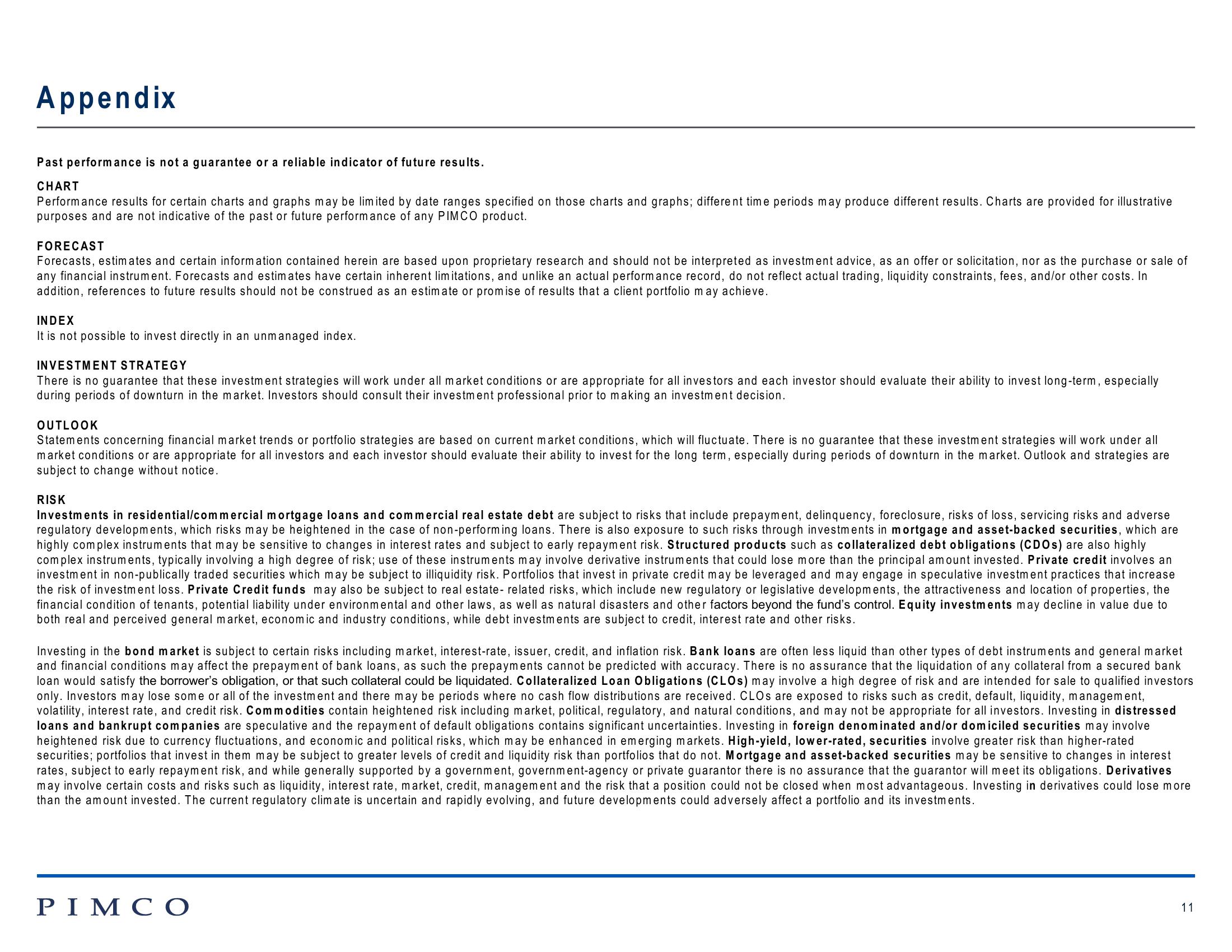Investing in Private Credit
Appendix
Past performance is not a guarantee or a reliable indicator of future results.
CHART
Performance results for certain charts and graphs may be limited by date ranges specified on those charts and graphs; different time periods may produce different results. Charts are provided for illustrative
purposes and are not indicative of the past or future performance of any PIMCO product.
FORECAST
Forecasts, estimates and certain information contained herein are based upon proprietary research and should not be interpreted as investment advice, as an offer or solicitation, nor as the purchase or sale of
any financial instrument. Forecasts and estimates have certain inherent limitations, and unlike an actual performance record, do not reflect actual trading, liquidity constraints, fees, and/or other costs. In
addition, references to future results should not be construed as an estimate or promise of results that a client portfolio may achieve.
INDEX
It is not possible to invest directly in an unmanaged index.
INVESTMENT STRATEGY
There is no guarantee that these investment strategies will work under all market conditions or are appropriate for all investors and each investor should evaluate their ability to invest long-term, especially
during periods of downturn in the market. Investors should consult their investment professional prior to making an investment decision.
OUTLOOK
Statements concerning financial market trends or portfolio strategies are based on current market conditions, which will fluctuate. There is no guarantee that these investment strategies will work under all
market conditions or are appropriate for all investors and each investor should evaluate their ability to invest for the long term, especially during periods of downturn in the market. Outlook and strategies are
subject to change without notice.
RISK
Investments in residential/commercial mortgage loans and commercial real estate debt are subject to risks that include prepayment, delinquency, foreclosure, risks of loss, servicing risks and adverse
regulatory developments, which risks may be heightened in the case of non-performing loans. There is also exposure to such risks through investments in mortgage and asset-backed securities, which are
highly complex instruments that may be sensitive to changes in interest rates and subject to early repayment risk. Structured products such as collateralized debt obligations (CDOs) are also highly
complex instruments, typically involving a high degree of risk; use of these instruments may involve derivative instruments that could lose more than the principal amount invested. Private credit involves an
investment in non-publically traded securities which may be subject to illiquidity risk. Portfolios that invest in private credit may be leveraged and may engage in speculative investment practices that increase
the risk of investment loss. Private Credit funds may also be subject to real estate- related risks, which include new regulatory or legislative developments, the attractiveness and location of properties, the
financial condition of tenants, potential liability under environmental and other laws, as well as natural disasters and other factors beyond the fund's control. Equity investments may decline in value due to
both real and perceived general market, economic and industry conditions, while debt investments are subject to credit, interest rate and other risks.
Investing in the bond market is subject to certain risks including market, interest-rate, issuer, credit, and inflation risk. Bank loans are often less liquid than other types of debt instruments and general market
and financial conditions may affect the prepayment of bank loans, as such the prepayments cannot be predicted with accuracy. There is no assurance that the liquidation of any collateral from a secured bank
loan would satisfy the borrower's obligation, or that such collateral could be liquidated. Collateralized Loan Obligations (CLOs) may involve a high degree of risk and are intended for sale to qualified investors
only. Investors may lose some or all of the investment and there may be periods where no cash flow distributions are received. CLOs are exposed to risks such as credit, default, liquidity, management,
volatility, interest rate, and credit risk. Commodities contain heightened risk including market, political, regulatory, and natural conditions, and may not be appropriate for all investors. Investing in distressed
loans and bankrupt companies are speculative and the repayment of default obligations contains significant uncertainties. Investing in foreign denominated and/or domiciled securities may involve
heightened risk due to currency fluctuations, and economic and political risks, which may be enhanced in emerging markets. High-yield, lower-rated, securities involve greater risk than higher-rated
securities; portfolios that invest in them may be subject to greater levels of credit and liquidity risk than portfolios that do not. Mortgage and asset-backed securities may be sensitive to changes in interest
rates, subject to early repayment risk, and while generally supported by a government, government-agency or private guarantor there is no assurance that the guarantor will meet its obligations. Derivatives
may involve certain costs and risks such as liquidity, interest rate, market, credit, management and the risk that a position could not be closed when most advantageous. Investing in derivatives could lose more
than the amount invested. The current regulatory climate is uncertain and rapidly evolving, and future developments could adversely affect a portfolio and its investments.
PIMCO
11View entire presentation